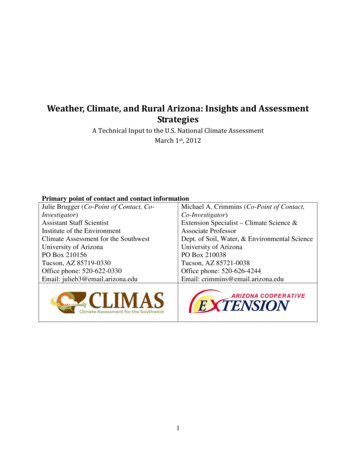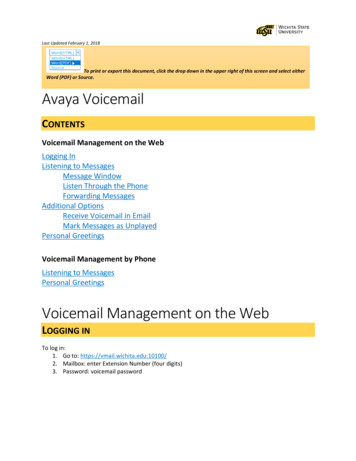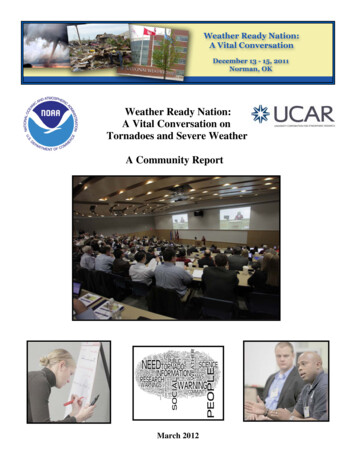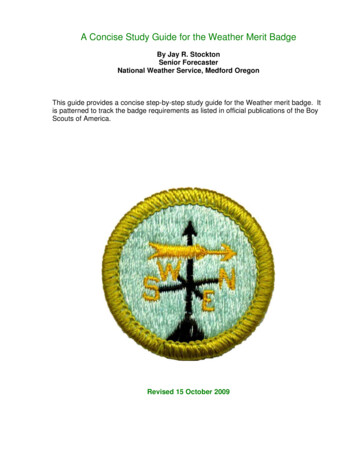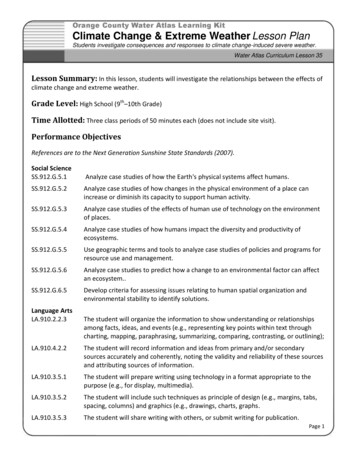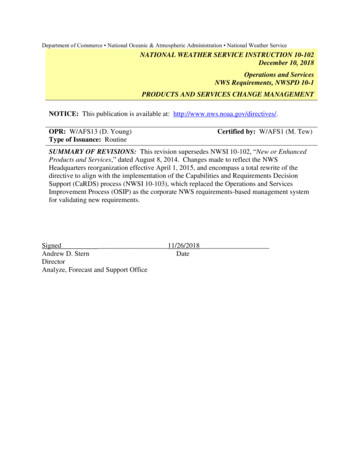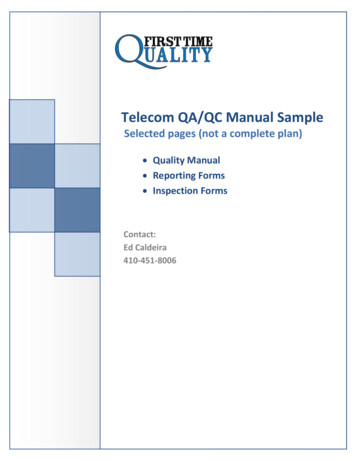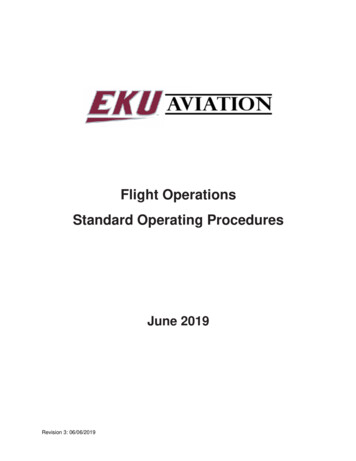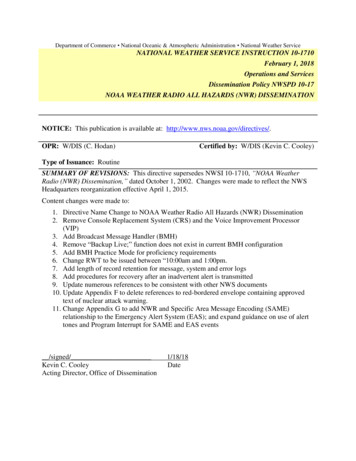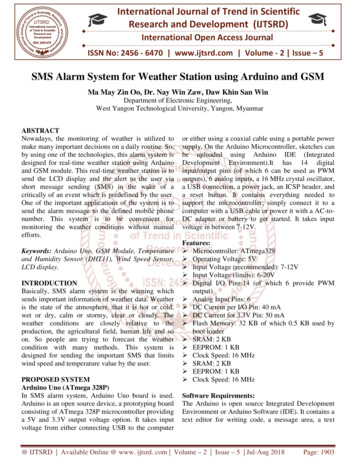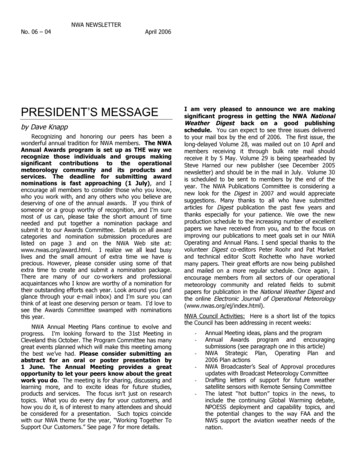
Transcription
NWA NEWSLETTERNo. 06 –04April 2006PRESIDENT’SMESSAGEby Dave KnappRecognizing and honoring our peers has been awonderful annual tradition for NWA members. The NWAAnnual Awards program is set up as THE way werecognize those individuals and groups makingsignificant contributions to the operationalmeteorology community and its products andservices. The deadline for submitting awardnominations is fast approaching (1 July), and Iencourage all members to consider those who you know,who you work with, and any others who you believe aredeserving of one of the annual awards. If you think ofsomeone or a group worthy of recognition,andI’msuremost of us can, please take the short amount of timeneeded and put together a nomination package andsubmit it to our Awards Committee. Details on all awardcategories and nomination submission procedures arelisted on page 3 and on the NWA Web site at:www.nwas.org/award.html. I realize we all lead busylives and the small amount of extra time we have isprecious. However, please consider using some of thatextra time to create and submit a nomination package.There are many of our co-workers and professionalacquaintances who I know are worthy of a nomination fortheir outstanding efforts each year. Look around you (andglance through your ervingpersonorteam.I’dlovetosee the Awards Committee swamped with nominationsthis year.NWA Annual Meeting Plans continue to evolve andprogress. I’m looking forwardtothe 31st Meeting inCleveland this October. The Program Committee has manygreat events planned which will make this meeting amongthe bestwe’ve had.Please consider submitting anabstract for an oral or poster presentation by1 June. The Annual Meeting provides a greatopportunity to let your peers know about the greatwork you do. The meeting is for sharing, discussing andlearning more, and to excite ideas for future studies,products and services. Thefocusisn’tjuston researchtopics. What you do every day for your customers, andhow you do it, is of interest to many attendees and shouldbe considered for a presentation. Such topics erToSupportOurCustomers.”See page 7 for more details.I am very pleased to announce we are makingsignificant progress in getting the NWA NationalWeather Digest back on a good publishingschedule. You can expect to see three issues deliveredto your mail box by the end of 2006. The first issue, thelong-delayed Volume 28, was mailed out on 10 April andmembers receiving it through bulk rate mail shouldreceive it by 5 May. Volume 29 is being spearheaded bySteve Harned our new publisher (see December 2005newsletter) and should be in the mail in July. Volume 30is scheduled to be sent to members by the end of theyear. The NWA Publications Committee is considering anew look for the Digest in 2007 and would appreciatesuggestions. Many thanks to all who have submittedarticles for Digest publication the past few years andthanks especially for your patience. We owe the newproduction schedule to the increasing number of excellentpapers we have received from you, and to the focus onimproving our publications to meet goals set in our NWAOperating and Annual Plans. I send special thanks to thevolunteer Digest co-editors Peter Roohr and Pat Marketand technical editor Scott Rochette who have workedmany papers. Their great efforts are now being publishedand mailed on a more regular schedule. Once again, Iencourage members from all sectors of our operationalmeteorology community and related fields to submitpapers for publication in the National Weather Digest andthe online Electronic Journal of Operational Meteorology(www.nwas.org/ej/index.html).NWA Council Activities: Here is a short list of the topicsthe Council has been addressing in recent weeks:-Annual Meeting ideas, plans and the programAnnual Awards program and encouragingsubmissions (see paragraph one in this article)NWA Strategic Plan, Operating Plan and2006 Plan actionsNWA Broadcaster’sSealofApprovalproceduresupdates with Broadcast Meteorology CommitteeDrafting letters of support for future weathersatellite sensors with Remote Sensing CommitteeThe latest“hotbutton”topicsinthe news,toinclude the continuing Global Warming debate,NPOESS deployment and capability topics, andthe potential changes to the way FAA and theNWS support the aviation weather needs of thenation.
Regarding the Global Warming debate and openscientific discussions on the topic, I wish to close thismonth’smessagewithaquotefrom NWA past PresidentTom Adang in the November 1997 Newsletter. Tomvoiced concern that we as a community need to,“ separate the science of global warming fromsocial/economic/political views that could taint objectiveanalysis of the data — a concern consistent with ourprofessional association's mission of enhancing thescience of operational meteorology and relateddisciplines." I believe this is an accurate statement weneedtoapplytotoday’scontinuing debate as well.- Sincerely, Dave Knapp (President@nwas.org)BUDGET PRESSURES IMPACTSATELLITE PROGRAMA recent Associated Press (AP) article warns that entalsatellites are at risk. Mounting budget pressures, changingscientific priorities and technical problems are challengingthe development of the next generation of Earth-observingsatellites and jeopardizing the continuity of space-basedenvironmental monitoring. A report by the NationalAcademy of Sciences issued last fall states that rapidlyshrinking federal budgets have placed Earth science andapplication programs at substantial risk. The y’dlikeabout impending natural disasters.Within NASA, a shift in scientific and fundingprioritiesfrom dtheagencytocancel,mothball,ordelay at least three planned research environmentalsatellites. NASA’sGlobalPrecipitation Measurementmission has been delayed until 2012 at the earliest; theHydros mission that was designed to make passivemicrowave measurements of soil moisture anddifferentiate between frozen and unfrozen ground hasbeen cancelled; and the Deep Space Climate Observatorywill also be cancelled.Tight budgets are also impacting the development ofthe next generation weather satellites. Cost overrunsresulting from technical and management problems on theNational Polar-orbiting Operational EnvironmentalSatellite System (NPOESS) that is jointly managed byNOAA, the Department of Defense, and NASA haveforced a Congressional review and recertification of theprogram. The first launch of NPOESS will likely bedelayed until 2010 at the earliest, and may even bestretched out to 2012. Because polar-orbiting operationalenvironmental satellites are critical to weather fNOAA’sPolar-orbiting Operational Environmental Satellites(POES) and the first NPOESS is a very serious concern.The full text of the AP article can be read online at:abcnews.go.com/Technology/wireStory?id 1689309LOCAL CHAPTER NEWSArkansas ChapterThe first Chapter meeting of the spring season washeld on 21 February at the NWS Office in North LittleRock. Thirteen members and guests were present.After a short business meeting was conducted byChapter President Chris Buonanno a presentation wasgiven by NWS Little Rock Senior Forecaster and IncidentMeteorologist (IMET) Joe Goudsward. His presentationwas about the NOAA/NWS Fire Weather Program. Hediscussed national fire statistics, the benefits of prescribedburning, and the wildland - urban interface. Focus thenshifted to the local NWS fire weather program and theservices that are provided by the Little Rock NWS Officeincluding fire weather forecasts, spot forecasts and IMETsupport. The role of the IMET and their specific dutiesand equipment were also discussed at length. Joe isroutinely detailed to wildfire sites across the country. Herecently traveled to Texas to provide IMET support to thestate during a large outbreak of wildfires.- Newton Skiles, Corresponding SecretaryCentral Iowa ChapterWe are sponsoring the golf event at the Iowa games inJuly 2006 with a donation of 1000. Planning has alsobegun for the 2007 Annual Severe Storms and DopplerRadar Conference which will be held 22-24 March 2007.- Janet Schenck, SecretaryNorth Texas ChapterThe March meeting presentation was given by VictorMurphy, Climate Service Program Manager at NWSSouthern Region Headquarters in Fort Worth. Victorexplained La Niña, what part of the Pacific Ocean ismonitored by the U.S. to determine if we are in a cold orwarm episode, current sea surface temperatures andtrends, weather patterns that typically exist in a La Niña,and the impact on North Texas. The current La Niñaconditions began in December and were expected tocontinue. North Texas usually experiences warmer anddrier than normal conditions during a La Niña. Outside ofone recent weekend with flooding rains, North Texas hashad below normal precipitation for the past 12 months.- Craig Nelson, Remote Sensing CommitteeGOES-N LAUNCH –18 MAY 2006The launch of GOES-N is scheduled for 18 May 2006between 6:14 and 7:14 PM EDT out of Cape Canaveral AirForce Station in Florida. This is the first in the new series ofmultimission GOES N-P satellites. This series will be a vitalcontributor to weather, solar and space operations, and science.NASA and NOAA are actively engaged in a cooperativeprogram to expand the existing GOES system with the launch ofthe GOES N-P satellites.The launch schedule is available at Web l- Janice Bunting2
Aviation Meteorology Award: This award is presented toan individual or group to recognize significant contributionsto aviation meteorology, such as impact of operationalforecasts on aviation operations or advances in aviationmeteorology including research in detection and forecastingof aviation hazards.Other Special Achievement Awards are detailed on theNWA Web site at: www.nwas.org/award.html. Names ofprevious annual award winners and additional awardinformation are also available on that Web site:Call for Nominations for the2006 NWA ANNUAL AWARDSThe National Weather Association (NWA) began itsannual awards program in 1977 to provide deservedrecognition to those individuals involved in operationalactivities. The NWA Annual Awards Program recognizes theprofessional as well as the volunteer. The emphasis is on thepeople who perform the day-to-day tasks of providingmeteorological information and weather support services tothe public.Please review the award categories carefully and use thecategory most appropriate for the nomination beingsubmitted.Award Categories are:Operational Achievement Individual Award: This awardis presented to a NWA member who has made a significantcontribution to operational meteorology. This could be foran accurate and timely forecast for one or more significantweather events or for long-period achievement in operationalweather support or related activities.Operational Achievement Group Award: This award ispresented to a group of two or more individuals for asignificant contribution to operational meteorology. At aminimum, a majority of the group (greater than 50%) mustbe NWA members.Member of the Year Award: This award is presented to aNWA member who has made significant contributions to theorganization over a period of time.T. Theodore Fujita Research Achievement Award: Thisaward is presented to a NWA member whose research hasmade a significant contribution to operational meteorology.Broadcaster of the Year Award: This award is presented toa NWA member Radio or Television weathercaster, or othermember of the broadcast media, whose activities havesignificantly contributed to the development and presentationof quality and timely weather information to the publicservice. Radio and Television weathercaster candidates mustbe current NWA Seal of Approval holders and have had theNWA Seal of Approval for at least one year prior to beingnominated for this award.The Larry R. Johnson Special Award: This award ispresented to an individual or a group to recognize uniqueevents or extraordinary accomplishments, which significantlycontributed to operational meteorology.Walter J. Bennett Public Service Award: This award ispresented to an individual or organization directly assistingthe meteorological community in providing weather-relatedinformation to the public. Individuals and organizations inthe meteorological profession are ineligible for this award.Public Education Award: This award is presented to anindividual or organization providing significant contributionsto increase the public's weather awareness.Local Chapter Award: This award is presented to a LocalChapter of the NWA whose activities have significantlyincreased awareness of the weather and of the NWA in theirlocal area.Submitting Nominations:Please use the award cover sheet that can be copied fromthe NWA Web site at: www.nwas.org/award.html or sentvia Fax from the NWA office (call: 434-296-9966), attacha narrative nomination (up to two pages in length) with nomore than three supporting letters of endorsement.Nominations should be mailed by 1 July 2006 to:NWA Awards CommitteeDaniel McCarthy, Chairperson1697 Capri WayCharlottesville, VA 22911-3534Although there is no rigid time requirement for the awards, itis preferred that the accomplishment, if not on a continuingbasis, occur within 18 months prior to the nominations. Selfnominations will not be accepted. If the nomination is notselected as the winner, it will remain a valid nomination for twoadditional years unless the nominee(s) are no longer in positionsapplicable to the award. The nomination may be updated by thesubmitter in each of those additional two years. Presentation ofthe annual awards for 2006 will be made at the NWA AnnualMeeting, Awards Luncheon, 18 October 2006, at theInterContinental Hotel in Cleveland, Ohio.NWA - SOL HIRSCH EDUCATIONFUND GRANTS for K-12 teachersThe NWA Education Committee needs help from allmembers, to inform teachers in grades K-12 that 500 grants areavailable annually from the NWA. These grants are designed tohelp teachers improve their meteorology education programs.The teachers selected will be able to use the funds to take anaccredited course in atmospheric sciences, attend a relevantworkshop or conference, or purchase scientific materials orequipment for the classroom. Seven grants or more are possiblethis year, thanks to the many members who have contributed tothis fund. The grants honor Sol Hirsch, who retired in 1992after being the NWA Executive Director for 11 years.Completed applications are due by 1 August 2006 to:NWA Education CommitteeP.O. Box 15011Baltimore, MD 21282-5011Application guidelines are available at Web site:www.nwas.org/solhirsch.html, or can be obtained via mail orfax by contacting the NWA office at NatWeaAsoc@aol.com orTel/Fax: (434) 296-9966.3
CALL FOR PAPERS –MEMBER NEWSTHE NWA METEOROLOGICAL SATELLITEAPPLICATIONS AWARDJeffrey Craven current NWA Councilor, Editor of theNWA Electronic Journal of Operational Meteorology andScience and Operations Officer (SOO) of the NWSForecast Office in Jackson, Mississippi, will soon beleaving Jackson to become the SOO of the NWS ForecastOffice in Milwaukee/Sullivan, Wisconsin. He will bereporting to the Milwaukee office on 1 June.The Meteorological Satellite Applications Award wasestablished by the National Weather Association (NWA) in1999 to stimulate interest and foster the study and use ofsatellite remote sensing data in weather analysis andforecasting. Undergraduate students are invited to writean original paper on meteorological satellite applications.Themes of the papers may include original research, casestudies, or a survey of applications. The recipient of theaward will receive a Grant of 500 and be invited topresent their paper at the NWA Annual Meeting. Thestudent must be enrolled as an undergraduate at the time thepaper is written and be in good academic standing at thecollege or university attending. The student must be a U.S.citizen or hold permanent resident status.Submission of Papers: Student papers should not exceed ten(10) pages including figures, photographs and appendices.Candidate authors should submit: an original and three copies of their paper a letter of application with the paper title, universityaffiliation, and contact information includingmailing address, phone, fax, and e-mail address ifavailable a letter from their Department Head or other facultymember that confirms the student author was anundergraduate when the paper was written and thatthe student is in good academic standing at thecollege or university. Additionally this letter shouldhighlight the original research or contributions thestudent has made to this paper.Ray Wolf,wasnamedthe“SeniorScientistoftheYear”by The Quad City Engineering and Science Council(QCESC). He was presented the award at the 44th AnnualNational Engineers Week Banquet held in February.According to a publication from the QCESC, Ray wasrecognized for his work in the NWS as well as his effortsto promote science knowledge in the local community.Ray is the Science and Operations Officer at the NWSForecast Office in Davenport, Iowa.IN MEMORIAMFrancis Joseph Socey, Jr., 92, of Weems, Virginia, diedSunday, March 19, 2006. He was a U.S. Army veteran ofWorld War II serving as a weather observer and aftertraining at MIT, he served as an instructor of meteorologyto pilots. Mr. Socey had a life-long interest inmeteorology, beginning at the age of 12. With athermometer placed under a rose rack in his hometown ofAltoona, Pennsylvania, the pre-teen began tracking dailytemperatures, rain dates, rainfall amounts and what the skylooked like. His mother also gave him a barometer whichbecame his steady companion through life. His interest inweather spanned almost 80 years while employed in manyjobs. He retired from the US Postal Service in 1975. Helived in New York, New Hampshire and Massachusettsprior to moving to Virginia in 1987 to live with ndhad a reputation for accurate forecasts. For many years, hewrote“Weather Review”,a monthlyarticlefortheRappahannock Record. He also was a regular contributorto the Atlantic Coast Observer Network. Mr. Soceyjoined the National Weather Association in 1978 and wasalso a member of many other professional and scientificorganizations. John Wilson wrote a profile on Mr. Soceyat: tand found his Favorite Pastime to be: “Weatheranalysis;”his Advice to Youth: "When you become interested insomething, make sure your parents help, regardless ofwhat it is;” and, his Greatest Influence: “Mymother,andDr. Charles F. Brooks, who was affiliated with the BlueHill Observatoryin Milton,Mass.” Surviving are hisdaughter, Margaret Ellen Socey and her husband PeterFallon both of Weems. Memorials may be made to theNorthern Neck Free Health Clinic, PO Box 1694,Kilmarnock, Virginia 22482 or a charity of choice.Submissions should be sent by 15 June 2006 to:National Weather AssociationAttn: MetSat Applications Award1697 Capri WayCharlottesville, VA 22911-3534Formal Announcement of the recipient of the award willbe made in October 2006 at the Annual Meeting (and earlierto the individual).HURRICANE NAMES RETIREDAn international committee of the WorldMeteorological Organization recently retired fiveAtlantic hurricane names from the 2005 season. The2005 season had the greatest number of stormnames retired in a single season since 1953 whentropical cyclones were first named.The 2005 names Dennis, Katrina, Rita, Stan andWilma will be replaced with Don, Katia, Rina, Seanand Whitney. The list containing these new nameswill be used in 2011.More information about these retired storms .gov/stories2006/s2607.htm4
MEETINGS OF INTERESTNEW COMET RESOURCES The Tenth Annual Great Divide Weather Workshopwill be held 3-5 October 2006 at the Sheraton Hotel inBillings, Montana.NOAA’s NationalWeather ServiceOffices in Billings and Glasgow are sponsoring thisworkshop that focuses on the exchange of weather andhydrologic forecasting information unique to the NorthernRockies and High Plains.Please submit abstracts ortopics to Wr.Great.Divide.Workshop@noaa.gov by 1 July2006. More information can be obtained on Web site:www.weather.gov/Billings, or by contacting the NWSForecast Office in Billings, at (406) 652-0851 orby e-mail: Wr.Great.Divide.Workshop@noaa.gov.Spring greetings from the COMET Program in Boulder!The past few months have seen the publication of 7 new trainingresources that span a broad range of topics that likely includesomething of interest to everyone. The subjects covered in thesenew materials include Broadcast Meteorology, SatelliteMeteorology, NWP Ensemble Prediction, Marine Meteorology,Radar Meteorology, Hydrology, and Tropical Meteorology.Read on below for more details or check out the "What's New"section of our MetEd site at: www.meted.ucar.edu.In January we published the module, Wave Life Cycle II:Propagation and Dispersion. The goal of this module is toenable a marine forecaster to manually predict how the waveheight and period will change as the waves leave theirgeneration area, become swell, and then propagate and disperseinto the forecaster's offshore coastal waters.Also, in January we launched the Broadcast MeteorologistCommunity Website (http://meted.ucar.edu/broadcastmet.php)that provides the Broadcast Meteorologists with a location foraccessing COMET modules, resource materials and links tosupport the professional development of the BroadcastMeteorologist and Weathercaster communities. This site alsoprovides initial information on a course being developed forBroadcast Meteorologistscalled, “Watersheds: ConnectingWeather to the Environment which is being developed incooperation with the National Environmental Education andTraining Foundation (NEETF) and with support from the EPA.In February we published a Website entitled, "Lectures onRadar Applications in Mesoscale Meteorology" that providesaccess to the streaming presentations and PowerPoint sourcefiles for the 11 lectures delivered during the AMS EducationalForum "A Primer on Radar Analysis Techniques Used inMesoscale Meteorology". The presentations discuss how manyadvanced techniques for the analysis of meteorological radardata can be used to improve understanding of the structure,dynamics, and evolution of mesoscale circulations.In March we published the third module in the BasicHydrologic Science Course series. The Streamflow Routingmodule offers a thorough introduction to streamflow routingmethods and applications in the river forecasting process. Thetarget audience for this module is meteorologistsworking in hydrology-related areas.And, most recently in early April we published:1) "Microwave Remote Sensing Overview", a module thatpresents an overview of space-based microwave remote sensingfor environmental applications.2) A new Website, the Ensemble Prediction System Matrix:Characteristics of Operational Ensemble Prediction Systems."3) A Webcast entitled, "Conceptual Models of Tropical Waves."These materials are freely available to everyone, courtesy ofCOMET sponsors who include NOAA's NWS andtheNOAA’sNESDIS GOES and NPOESS programs, the AirForce Weather Agency, the Naval Meteorology andOceanography Command, the Meteorological Service ofCanada,andAustralia'sBureauofMeteorology.We hope that this broad array of training topics includessomething of interest to help meet your own professionaldevelopment goals. The Tenth Annual High Plains Conference will be held4-6 October 2006 in Dodge City, Kansas. The High PlainsChapter of the AMS-NWA sponsors it. The theme,High Plains Severe Storms, will focus on events rangingfrom severe thunderstorms and tornadoes, to drought, duststorms, flash flooding, and winter weather. Topics from boththe research and the operational communities are welcome.Each session will open with an invited speaker. Remainingspeakers will each receive 20 minutes for their presentationsand any questions. This conference is intended to be lessformal than national conferences, so those who arepresenting for the first time, and those whose work has notyet gone through the academic peer review process, arewelcome to participate. The Chapter will sponsor a studentcompetition. Students are encouraged to submit papers forpresentation on all topics in meteorology. First and secondplace papers will receive scholarships of 500 and 250respectively. Students should contact the ConferenceCommittee for information. The deadline for submission oftitles and one page abstracts is 8 September 2006. Pleaseincludethe author’sname and affiliation,correspondingauthor address, telephone/fax number, and e-mail address.Send submissions to: Tenth High Plains ConferenceCommittee, National Weather Service, 104 Airport Road,DodgeCity,KS67801(tel:620-225-6514;fax: 620-227-2288; e-mail: Matt.Gerard@noaa.gov).For more information contact the Conference Committee orvisit Web site: www.highplains-amsnwa.org. TheNWA’s31st Annual Meeting will be held at theInterContinental Hotel, 9801 Carnegie Avenue,Cleveland, Ohio, 14–19 October 2006. Go to page 7 of thisNewsletter, or the NWA Web site: www.nwas.org fordetails. The Seventh New England Weather Conference will beheld on 28 October 2006 at the facilities of the Dexter andSouthfield Schools, and the Clay Center Observatory, inBrookline, Massachusetts. It is sponsored by the SouthernNew England Chapter of the NWA and several othersponsors. Watch the Chapter Web site for details.www.sneweatherconf.org/index.shtml- Wendy Schreiber-Abshire (abshire@ucar.edu)5
Concurrent with development of the new Guam FireWeather Program, the USDA Forest Service organized aForestry Management Course for the forestry and firepersonnel of the Pacific. At the request of the USDA,WFO Guam participated, conducting 12 hours of lectureson Pacific Climate and Fire Weather. Dr. Mark Lander, aUniversity of Guam and Pacific ENSO ApplicationsCenter meteorologist and WFO Guam partner, alsopresented lectures.On 1 June 2005, WFO Guam officially kicked off itsformal Fire Weather Program for Guam, with the issuanceof its first Fire Weather Planning Forecast. Other productsinclude Fire Weather Watches and Red Flag Warnings,Spot Forecasts for agencies involved in fighting wildfiresor prescribed burns, graphical images available from theNational Digital Forecast Database, and WeatherInformation Management System (WIMS) observationsand point forecasts for sites in southern and central Guamin support of the NFDRS. At the request of its customers,WFO Guam recently added Keech-Byram Drought Indexforecasts to the Planning Forecast. The Guam FireWeather Program is greatly appreciated by the Division ofForestry and the local fire-fighting community. Theprogram will likely be expanded to include theneighboring islands of the Commonwealth of the NorthernMariana Islands (CNMI) in the next year or two. Many ofthe other islands of Micronesia experience similar firethreats, and have expressed the desire to develop a fireweather program.GUAM FIRE WEATHERGuam Wild Land Fire CharacteristicsGuam is well known for its location in TyphoonAlley, and for having the highest risk of getting hit by atropical cyclone of any U.S. coastal location. Believe it ornot, Guam also has the greatest number of fires per unitarea of any U.S. location. Virtually all of the fires onGuam are human-caused. Fires are occasionally started byunattended backyard trash burns, and by poachers andbetel nut gatherers who want easy access to hunting andharvesting sites. Poachers will burn to either flush outgame or to attract them back to tender young seedlinggrowth a few weeks after the burn. These are often themost serious fires because they are often inaccessible.The majority of wild land fires on Guam are started fromthe careless disposal of cigarette butts from movingvehicles during dry periods. Lightning has not beenknown to cause wild land fires on Guam since lightningdoes not normally occur in the dry season.Guam Dry Season and Fire ThreatAre severe drought conditions possible on a tropicalisland where the average annual rainfall is around 100inches? Theanswerisanunequivocal“yes”! Guam hastwo main seasons—the wet season and the dry season.Normally, the dry season lasts from December throughMay, with the six months from June through Novemberconstituting the wet season. By CONUS standards, eventhe dry season is rather wet, averaging about 4-5 inches ofrain per month. However, when less than 4 inches of rainfalls in a month or so, dew stops forming, and the grassesand other fuels on the sun-parched hillsides dry outrapidly. The most severe dry periods occur during thewinter and following spring months of a moderate orstrong El Niño event. Strong subsidence and strengthenedtrade winds during these events lead to a long period ofvery dry conditions and a very high risk of wild land fires.Table 1 illustrates the severe wild land fire problem Guamfaces in association with moderate and strong El Niñoevents. Note the severity of back-to-back (two year)occurrences.NWS Forecast Office Guam Fire Weather ProgramThe NWS Weather Forecast Office (WFO) Guamformal Fire Weather Program began in the fall of 2004.The spin-up process included months of coordination withregional and national weather and forestry people,installation of a fire weather observing system (RAWS)and a fuel stick measurement site, determination ofcustomer needs and Red Flag criteria, development ofIFPS (Interactive Forecast Preparation System) formattersand smart tools, production of a Station Duty Manual andReference Binder, development and execution of seminarsand training sessions, and the acquisit
was about the NOAA/NWS Fire Weather Program. He discussed national fire statistics, the benefits of prescribed burning, and the wildland - urban interface. Focus then shifted to the local NWS fire weather program and the services that are provided by the Little Rock NWS Office including fire weather forecasts, spot forecasts and IMET support.
